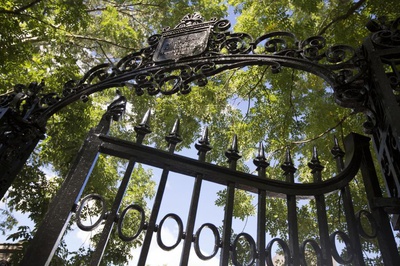
News
Harvard Researchers Develop AI-Driven Framework To Study Social Interactions, A Step Forward for Autism Research

News
Harvard Innovation Labs Announces 25 President’s Innovation Challenge Finalists

News
Graduate Student Council To Vote on Meeting Attendance Policy

News
Pop Hits and Politics: At Yardfest, Students Dance to Bedingfield and a Student Band Condemns Trump

News
Billionaire Investor Gerald Chan Under Scrutiny for Neglect of Historic Harvard Square Theater
Herbert Read Credits Greek Art With Start of Humanism, Idealism
With the synthesis of vital form and formal beauty which marked the birth of Humanism, the Greek sculptors of the Fifth Century B.C. opened up a new dimension of human consciousness, Sir Herbert Read told his audience in the fourth Charles Eliot Norton Lecture of the year last night.
Further developing his overall theme of "Art and the Development of Human Consciousness," Read discussed the dichotomy of ancient Greek art and placed special stress on the evolution of "ideal" standardized forms or types in sculpture.
Read opened the lecture, "The Idea as Human," with a statement of his basic thesis that human consciousness of reality is first made concrete in works of art and only later developed into ideas. "The plastic symbols of art," he said, make all our abstract cogitations basically possible.
"It was inevitable that man should try to represent the self," Read pointed out, because it was through the action of this "self" or consciousness that he converted any experience into its expression in creating a work of art. But consciousness of the universal self naturally preceded consciousness of an individual self, he added.
Hence, the Greek sculptors sought to combine that harmonic proportion of general forms which had been discovered by the neolithic artists with the vital image of man. They began by applying basic geometric principles to the frontal representation of the human figure.
In the Fifth Century B.C. the Attic sculptors finally achieved this synthesis of the vital image of man with the geometric abstract of beauty which they had been seeking. It was this achievement of a true idealism in art which gave the world Humanism, and which was the unique achievement of Greek culture, Read said.
He offered the figures on the frieze of the Parthenon as the most perfect examples of this artistic Humanism and idealism in the Ancient World. They represent that point of equilibrium at which "an inner vitality responds and corresponds to an outer measure," he concluded.
Greek vase painting--the other branch of the dichotomy--was not so significant as sculpture, because the instinctive expressionism which characterized it was not unique.
Want to keep up with breaking news? Subscribe to our email newsletter.
Most Read
- Harvard Kennedy School Dean Denounces Visa Revocations in Email to Affiliates
- Harvard Is Turning Its Back on Scholasticide in Palestine
- More Than $110 Million in NIH Grants to Harvard, Affiliated Hospitals Terminated Since Late February
- After Trump’s Demands, Dean of Students Says College Diversity Offices Have No Plans To Cut Programming
- Harvard AAUP Sues Trump Administration To Stop $9 Billion Review of Harvard’s Federal Funding
From Our Advertisers

Over 300+ courses at prestigious colleges and universities in the US and UK are at your disposal.

Where you should have gotten your protein since 1998.

Serve as a proctor for Harvard Summer School (HSS) students, either in the Secondary School Program (SSP), General Program (GP), or Pre-College Program.

With an increasingly competitive Law School admissions process, it's important to understand what makes an applicant stand out.

Welcome to your one-stop gifting destination for men and women—it's like your neighborhood holiday shop, but way cooler.

HUSL seeks to create and empower a community of students who are seeking pathways into the Sports Business Industry.
